MANAGED AQUIFER RECHARGE (MAR) is a nature-inspired solution that aims at intentionally recharging the aquifers with surface water for later use or environmental benefits. One of the main characteristics of MAR is that it provides for water storage in the subsurface in comparison with conventional storage in big surface reservoirs.
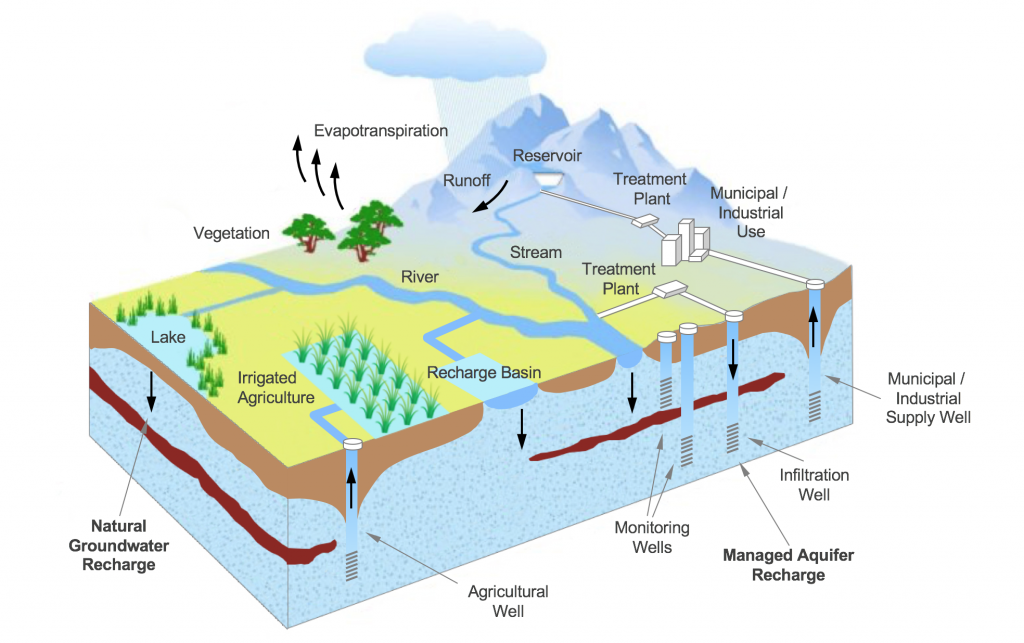
Recharge techniques
There are manifold MAR methods available and several classification schemes exist (see the complete list here). The tools on the INOWAS platform are based on the classification system developed by the International Groundwater Resources Assessment Centre, IGRAC (Stefan and Ansems, 2017):
Table 1. Classification of MAR methods (adapted from IGRAC, 2015)
| Main MAR methods | Specific MAR methods | |
| Techniques referring primarily to getting water infiltrated | Spreading methods | Infiltration ponds (SAT) |
| Flooding | ||
| Ditches and furrows | ||
| Excess irrigation | ||
| Induced bank infiltration | River/lake bank filtration | |
| Dune filtration | ||
| Well, shaft and borehole recharge | ASR/ASTR | |
| Shallow well/shaft/pit infiltration | ||
| Techniques referring primarily to intercepting the water | In-channel modifications | Recharge dams |
| Subsurface dams | ||
| Sand dams | ||
| Channel spreading | ||
| Runoff harvesting | Rooftop rainwater harvesting | |
| Barriers and bunds | ||
| Trenches |
Techniques referring primarily to getting water infiltrated
 Spreading methods
Spreading methods
These are technologies that focus on enhancing gravitational infiltration and percolation of water to unconfined aquifers through structures above or at ground level that retain water or enhance percolation. They include infiltration ponds (SAT), flooding, ditches and furrows, and excess irrigation.
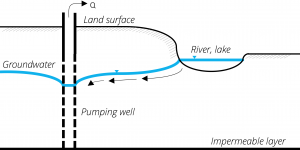 Induced bank filtration
Induced bank filtration
Induced bank filtration combines methods that enhance infiltration of surface water induced by pumping from a nearby well. Water quality improvement of the induced surface water is commonly the main objective among these techniques.
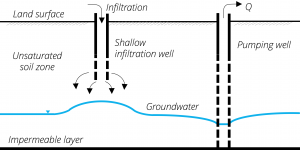 Wells, shafts and boreholes recharge
Wells, shafts and boreholes recharge
Groundwater recharge through wells, shafts and boreholes sums up all methods that utilize gravitational recharge through shallow constructed shafts, pits, boreholes or recharge by direct injection of water through wells. These technologies are used mainly when low permeability strata is present above the targeted aquifer and include ASR, ASTR and infiltration through shallow wells, shafts or pits.
Techniques referring primarily to intercepting the water
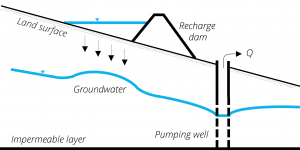 In-channel modifications
In-channel modifications
In-channel modifications comprise structures built in drainage channels that intercept or delay run-off, thus, enhancing infiltration and groundwater recharge. They are mainly built in intermittent or ephemeral streams with distinct seasonal rain regimes. Examples include: recharge dams, subsurface dams, sand dams and channel spreading structures.
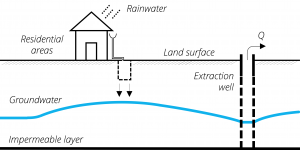 Runoff harvesting
Runoff harvesting
Rainwater harvesting comprises methodologies for collecting rain or storm water runoff. In case of MAR, this involves the concentration of rainfall to recharge the groundwater through: rooftop rainwater harvesting structures, barriers and bunds, trenches.
Objectives and benefits
MAR can be applied to tackle a wide range of water-related problems. Many of these applications can be assessed by the INOWAS platform.
Often recharge activities are conducted to increase water availability or to mitigate effects of preceding groundwater overexploitation. Maximizing natural storage can include seasonal storage of water during times of high availability (rain season) for periods high demand (dry season). Long-term storage (“water banking”) can be a strategic measure for the sustainable management of groundwater resources.
Physical aquifer management through MAR comprises the restoration of depleted groundwater levels, reduction of land subsidence caused by depleting groundwater tables and the prevention or mitigation of saltwater intrusion in coastal areas.
Further potential for MAR application lies within water quality management where the aim is to improve the water quality for the recharged water or the water in the aquifer. This includes surface infiltration as an additional treatment step for treated waste water (as practiced in SAT) or as dilution for brackish aquifers. As water quality management needs careful monitoring, the assessment of the risk of contaminant breakthrough during MAR needs to be regarded. To obtain a sustainable and economically feasible MAR system, the achievable recovery efficiency as well as the development of clogging during the operation of MAR are factors that are of particular interest.
The INOWAS platform can be used to plan or optimize MAR facilities. This includes finding the optimal location for MAR schemes, assessing parameters for optimal design and operational management and quantify the effect of MAR on other groundwater users.
Next to these objectives that are mostly benefiting human needs, MAR may also have ecological benefits. These could include maintaining of surface water flows such as reserves and in-stream flow.
External links to read more
- Managed aquifer recharge – An introduction
- Strategies for MAR in semi-arid areas
- Indian manual on artificial groundwater recharge
- Australian guidelines on MAR implementation
References
- DEMEAU. (2014). Characterization of European managed aquifer recharge (MAR) sites – Analysis.
- Dillon, P., et. al (2010). Managed aquifer recharge: rediscovering nature as a leading edge technology. Water science and technology, 62(10), 2338-2345. doi: 10.2166/wst.2010.444
- IGRAC. (2007). Artificial Recharge of Groundwater in the World.
- Stefan, C., Ansems, N. (2017) Web-based global inventory of managed aquifer recharge applications. Sustain. Water Resour. Manag., DOI: 10.1007/s40899-017-0212-6
- Todd, D. K. (1959). Annotated bibliography on artificial recharge of ground water through 1954. Washington, DC: US Government Printing Office.
